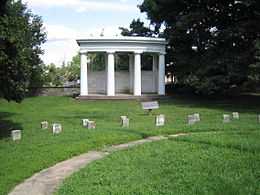Battleground National Cemetery
|
Battleground National Cemetery | |
 | |
|
Forty-one Union soldiers killed at the Battle of Fort Stevens were buried at Battleground National Cemetery, a few blocks from the site of the battle | |
 | |
| Location | 6625 Georgia Ave., NW., Washington, District of Columbia |
|---|---|
| Coordinates | 38°58′14″N 77°1′37″W / 38.97056°N 77.02694°WCoordinates: 38°58′14″N 77°1′37″W / 38.97056°N 77.02694°W |
| Area | 1 acre (0.40 ha) |
| Built | 1864 |
| Governing body | National Park Service |
| NRHP Reference # |
66000032 [1] |
| Added to NRHP | October 15, 1966 |
Battleground National Cemetery is a military burial ground, located along Georgia Avenue near Fort Stevens, in Washington, D.C.'s Brightwood neighborhood. The cemetery is managed by the National Park Service, together with other components of Rock Creek Park.
Battle of Fort Stevens
The Battle of Fort Stevens, which took place on July 11–12, 1864, marked the defeat of General Jubal Anderson Early's Confederate campaign to launch an offensive action against the national capital. During the battle, 59 soldiers were killed on the Union side.[2] There were approximately 500 casualties on the Confederate side of the battle.[3]
Burials
After the battle, Quartermaster General Montgomery C. Meigs seized 1 acre (0.40 ha) of farm land to use for burying the dead. Under direction from President Abraham Lincoln and Meigs, forty were buried on the evening of July 12 on the battlefield site. That night, Lincoln came to the site to dedicate it as the Battleground National Cemetery. It was declared that anyone who fought in the battle was permitted to be buried at the location. But only one veteran of the battle, Edward R. Campbell, was buried in the cemetery in March 1936 at the age of 92. Four of the family members (the mother and three children) that lived in the caretaker's house on the site are also buried at the cemetery. All of them died within ten years of each other. The cemetery is now a closed site and no more burials are permitted.[4]
In addition to the grave markers, the cemetery includes four monuments to units that fought at Fort Stevens, including the 25th New York Volunteer Cavalry, 98th Pennsylvania Infantry, 122nd New York Infantry, and the 150th Ohio National Guard.[2]
Administration
The piece of land was previously part of a fruit orchard owned by farmer James Malloy.[5] When he returned to his land after the dust cleared from the battle, Malloy was upset that his land was taken and challenged the action. Through an act of Congress passed on February 22, 1867, the land was acquired and officially transferred to the government on July 23, 1868 with payment made to Malloy.[3]
A superintendent's lodge was built in 1871,[6] using a basic stone design by General Montgomery Meigs that was a prototype for all national cemeteries. The lodge was built as a residence for the superintendent of the cemetery. The superintendent's lodge was added to the National Register of Historic Places on April 4, 1980.[4]
Battleground National Cemetery was administered by the United States Department of War until 1933-34, when it was transferred to the National Park Service.[4] The cemetery was administratively listed on the National Register on October 15, 1966, and is one of the smallest national cemeteries.[7]
In 2005, the DC Preservation League listed the cemetery as one of the most endangered historic sites in Washington, D.C. The National Park Service has been allocated funds under the American Recovery and Reinvestment Act of 2009 for restoration work at Battleground National Cemetery.[6]
See also
- National Register of Historic Places listings in the District of Columbia
References
- ↑ "National Register Information System". National Register of Historic Places. National Park Service. 2009-03-13.
- ↑ 2.0 2.1 "Civil War Defenses of Washington". National Park Service. Retrieved 2009-09-19.
- ↑ 3.0 3.1 United States Congress, House Committee on Appropriations (1921). Sundry Civil Appropriation Bill. pp. 2770–2774.
- ↑ 4.0 4.1 4.2 "List of Classified Structures". National Park Service. Retrieved 2009-09-20.
- ↑ McGowan, Elizabeth (2009-07-01). "I Couldn’t Give Up on These Guys". Washingtonian. Retrieved 2009-09-19.
- ↑ 6.0 6.1 "Nationwide Cemetery Preservation Summit Schedule and Abstracts". National Center for Preservation Technology and Training. Retrieved 2009-09-19.
- ↑ "District of Columbia Inventory of Historic Sites" (PDF). District of Columbia Office of Planning. September 2004. p. 46. Retrieved 2009-09-19.
| ||||||||||||||||||||||||||